A complementary Musicarta Patreon module!
Staggered Pentatonic Scales
Page 2 - Jamming Module
This is the second page of the Staggered Pentatonic Scales improvisation work-out. For maximum benefit, work through Page One first.
The talking heads videos explaining how to use this material are all in the Mister Musicarta YouTube Staggered Pentatonic Scales playlist.
Jamming over the three-four bass
Here's a run-together up-to speed selection of treble (right hand) riffs and chord textures. The left hand is taken from the Staggered Pentatonic Scales module riff, on the first page.
Watch, paying close attention to the titles, so you understand what's significant and what you're aiming at.
The practice segment videos
Now here are the practice segments at a comfortable 90 bpm. They're set to repeat - the joint won't be seamless, but good enough to play along to. You'll have to stop them playing manually.
You can dot about and work through them in any order. Some of the later ones are in fact easier than the earlier ones.
The aim is the keep a beat going and try out ideas in your right hand. Feeling absolutely rubbish at it initially is normal! If persistence didn't pay, it would be a very sad world.
Segment 1
'Placeholder' left hand plays a single beat per bar; right had plays five-note triplet quaver strings starting just after the left hand.
The last two RH phrases are strung together, for rhythmic variety.
Work out a fingering that works for you.
Segment 2
A new, less frantic left hand - a variety of the standard "two up, two down", i.e. two minor pentatonic scale-tones above and two below the bass (with a optional grace note).
Ignore the F sharp 'grace note' if it gives you trouble.
Segment 3
Now with the original left hand riff.
It's important here to work out which LH note goes with which RH note and to play accurately, or it can sound very messy.
You can always stick with the simple "two up, two down" left hand. The idea is to come away happy, not feeling defeated!
The Musicarta
PENTATONICS WORKBOOK
|
The immediately recognizable five-tone pentatonic scales are easy to find and underpin much of the popular music we all love. The Musicarta Pentatonics Workbook is a fully featured video course with 50+ web-page lessons, accessible to players of all levels and orientations. This workbook is sure to give your musical adventuring a powerful boost! |

|
|
Click through to the Pentatonics Workbook YouTube playlist here.
Some material also available on Musicarta Patreon.
Segment 4
Now with the original left hand riff.
It's important here to work out which LH note goes with which RH note and to play accurately, or it can sound very messy.
You can always stick with the simple "two up, two down" left hand.
Segment 5
Take a break and play some chords in the right hand.
There are three chords. Work out what they are and what fingers feel best.
Think of them as bottom (B), middle (M) and top (T), and notice the order they come in. It's patterned.
The four groups played here are:
- B M B M B M T M
- T M T M T M B M
- B M B M B M T M
- B M T M T M T M
They all have a slightly different character - all 'say something' slightly different.
You should be able to look at those four lines above and hear them in your head.
Take the opportunity the try out your own sequences.
Segment 6
New right hand material - four rising five-note strings, four falling.
You can try this over the simpler left hand pattern in Segment 9.
Segment 7
Take a break with some right hand chords, again.
A slightly different rhythm - more anticipation, so the chords are more evenly spaced.
Use the 'falling columns' in the video to match the chords up with the notes of the familiar left hand riff.
MUSICARTA PATREON
A new way to study keyboards
|
Enjoy access to a whole bunch of Musicarta workbooks, repertoire and theory-in-practice learning material, with exclusive new content being added all the time! At only $5.00 a month, Musicarta Patreon Tier One can be your creative keyboard companion, encouraging and supporting your endeavors with a broad variety of creative learning opportunities. Accessible to players of all levels and orientations, Musicarta Patreon Tier One is an excellent way to signal your intention to nurture your creative side! |
Contents include: The Musicarta Hanon - remade for the modern keyboardist 'Scale City' - the essential video resource for easy scale mastery The Beat & Rhythm Workbook - tackle syncopation methodically! Pyramids Variations - 'composing at the keyboard' for beginners 'Majestic River' - a beautiful rock chord study/piano solo Musicarta Easy Piano Style - aka new 'Play like Enya' video pages |
...and lots, lots more!
Browse the Musicarta Patreon sample content page here!
Segment 8
The Segment 6 material, falling only.
Try choosing a different four notes to descend from, that 'fits' and sounds right. The options are limited, you'll find!
Segment 9
The RH 4 x 5-note strings over the simpler left hand.
Try mix-and-matching the 5-note groups, one rising, one falling, for example.
Segment 10
New Right hand chord work: hold the middle C down and 'flap' the outer 'voices'. (There's a new straight F7 chord in there.)
The left hand defaults to the easier version, and a new chord pattern appears, with a 'stab' at the tonic thrown in. That doesn't have to be an octave, btw... a good, loud single note would do.
Segment 11
A new chord rhythm, with a 'stab' at the tonic thrown in. That
doesn't have to be an octave, btw... a good, loud single note would do.
Tap your foot! It's a no-no for classical pianists, but not for us (except in the recording studio).
SCALE CITY
An essential resource for popular-styles pianists
|
Should popular-styles pianists 'bother' to learn their scales? Yes! Of course, you will want to be able to rip up and down your keyboard, regardless of how many black keys get in the way. But, more than that, learning the scales is the best way to learn the keys. Too many popular-styles keyboard players are nervous of playing in three/four/five sharps or flats. That's not something the 'really useful' keyboard player can settle for! |
Reference video performances of all 36 major, melodic minor and harmonic minor scales. Why those notes are in those scales. Once you understand that, the keys are obvious! A methodical explanation of the scale fingering - much better than just following your nose... Proven ways to accelerate your progress - practice patterns, visual scale keyboards and more. The 'other scales' - pentatonic major and minor and the modes. |
Bite the bullet and start your (catch-up?) campaign now!
Scale City is exclusively available on Musicarta Patreon
Browse the Musicarta Patreon sample content page here!
Segment 12
Longer melodic strings. Notice the resulting change in pace.
- Six notes descending to the (repeated) tonic;
- Six notes ascending to the (repeated) tonic;
- Descending from a lower note; overshoot and come back;
- The inverse, from below.
Segment 13
This pattern is built from the elements above. What is it?
Devise other patterns with the from above/from below, overshoot/no overshoot options.
Segment 14
This is the Segment 12 material over the easier left hand.
Devise other patterns with the from above/from below, overshoot/no overshoot options.
Segment 15
Heading for the exit - the 'outro'.
The chord work is sort-of the opposite of Segment 10: you hold the outer notes of the chord and put some rhythm in by 'flapping' the middle finger.
Plus (optional) stab at the tonic.
Aaaaand, fade to black...
...or, go back to Page One and embed those scales drills!
The MusicartaA methodical approach to keyboard syncopation for
|
PUBLICATIONS
exciting keyboard
creativity courses
CHORDS 101
WORKBOOK

~HANON~
video course

Musicarta
Patreon
PENTATONICS
WORKBOOK
video course

Creative Keyboard
video course

BEAT AND RHYTHM
WORKBOOK
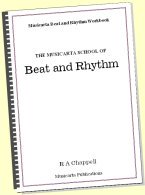
- Volume 1 -

12-BAR PIANO
STYLES WORKBOOK
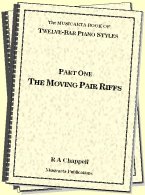
MUSICARTA MODES
WORKBOOK
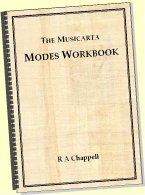
PIANO STYLE
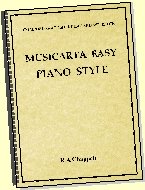
CANON PROJECT
video course
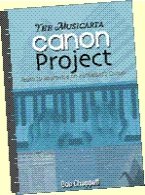
VARIATIONS
video course

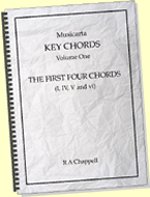
- Piano Solo -
video course
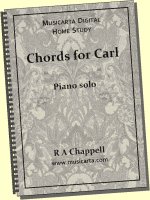
- Piano Solo -


YouTube playlists





 THE LOGO
THE LOGO
